Home >> Diversity and classification >> True fungi >> Dikarya >> Ascomycota >> Plectomycetes >> Onygenales
ONYGENALES
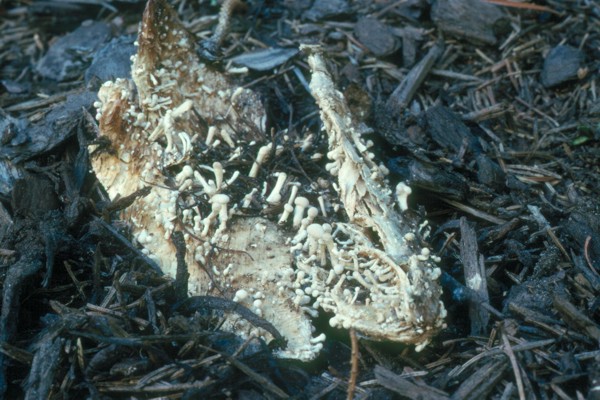
The large object in the image at right is the decomposing hoof of a long-dead moose. The white club-shaped objects standing on it are the ascomata of Onygena equina, a fungus most commonly found on old hooves, horns and feathers. In our region it is found most often on moose hooves, but that is only because moose are our most common large animal. It grows just as well on the hooves of cows and horses. Hooves, hair, feathers, skin and horns (but not antlers) are composed of keratin, a complex protein that most fungi cannot digest. By being able to use keratin O. equina has access to a rich source of nutrients. However, it is not alone; many members of the Onygenales are able to digest keratin and because of this have become dominant organisms in environments where keratin is available. These are largely animal-associated fungi that are most easily found around the dens and droppings of vertebrate animals. Before you go rushing out to look for them you should be aware that some members of the Onygenales are capable of causing human diseases, ranging from simple skin infections to fatal invasions of internal organs.
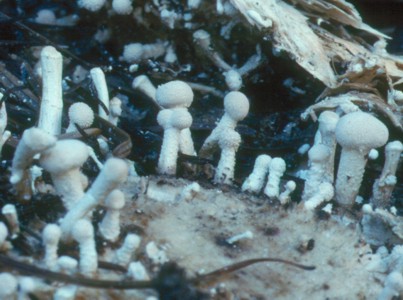
A closer view of O. equina shows them looking like little mushrooms with a stipe and a cap. The stipe is composed of hyphae that never produce asci and ascospores; its only role seems to be to raise the cleistothecia above the substrate. The "cap" is a sort of compound cleistothecium. It is initially made up of sterile hyphae, but eventually several clusters of asci begin to develop inside it. By the time it is mature the cleistothecium is filled with asci and spores. The asci dissolve and the ascospores disperse as the surface layers of the cleistothecium disintegrate. It is not known how the ascospores find their way to a new hoof, but it is not likely that they would hit such a small target by random dispersal in the air. Perhaps they are carried by insects specialized in visiting old hooves and horns, or maybe they exist as "subclinical infections" in the hooves of living moose and only fruit when the animal dies.
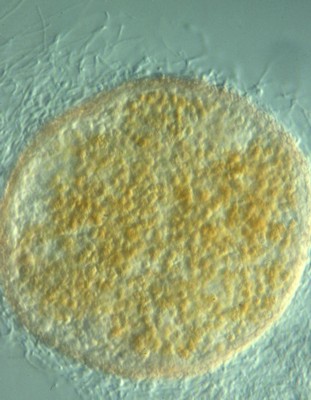
Species of Aphanoascus, such as A. fulvescens at right, are commonly encountered on the dung of rodents and carnivorous animals, particularly if it contains a lot of hair. These fungi are smaller and less complex than species of Onygena yet share their affinity for keratin. It might at first seem difficult to distinguish species of Aphanoascus from those of Aspergillus or other Eurotiales but they have some typical onygenalean characteristics that make them recognizable. First of all, the orange to pinkish brown colours seen in the photo, especially in the wall of the cleistothecium, are quite typical of the Onygenales and differ from the bright yellow to red or purple colours seen in the Eurotiales. Of course some members of both groups can have colourless cleistothecia and ascospores, so colour is not an absolute indication of where a species belongs.
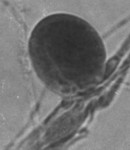 Secondly, while most Eurotiales have prominantly coiled ascogonia such as those of Aspergillus, members of the Onygenales may produce quite different different types, like the spherical ascogonium of Aphanoascus seen at left. Finally, none of the Onygenales produce their asexual spores from phialides, something nearly all Eurotiales do. Phialides are a widespread and characteristic type of enteroblastic conidiogenesis. Members of the Onygenales usually have holoblastic or even thallic conidiogenesis. It may be helpful to review the discussion of anamorphs to fully appreciate these important differences.
Secondly, while most Eurotiales have prominantly coiled ascogonia such as those of Aspergillus, members of the Onygenales may produce quite different different types, like the spherical ascogonium of Aphanoascus seen at left. Finally, none of the Onygenales produce their asexual spores from phialides, something nearly all Eurotiales do. Phialides are a widespread and characteristic type of enteroblastic conidiogenesis. Members of the Onygenales usually have holoblastic or even thallic conidiogenesis. It may be helpful to review the discussion of anamorphs to fully appreciate these important differences.
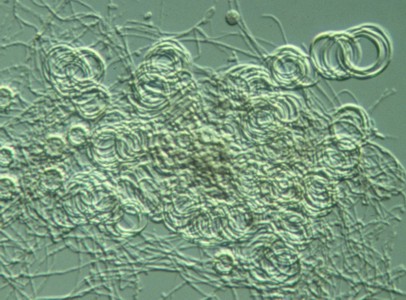
Some members of the Onygenales have cleistothecia with rather loose hyphal walls that allow the mature ascospores to sift out gradually. Such cleistothecia, sometimes termed "gymnothecia" are common in the same sorts of animal-associated habitats as Aphanoascus species. They often have appendages arising from the surface of the cleistothecium such as the coiled elements characteristic of Ajellomyces capsulatus seen at left. Dr. Randy Currah at the University of Alberta has suggested that these appendages aid in dispersal of the fungus by catching in the fur or feathers of associated animals or on the bristles of insects.
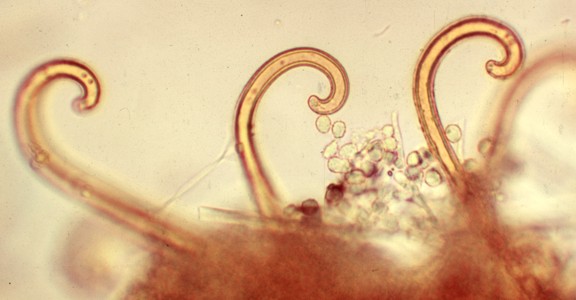 It's not difficult to image the hooked cleistothecial appendages of Gymnoascus uncinatus clinging to fur or feathers while the spores slowly sift out of the cleistothecium into the environment. Some gymnothecial fungi that may appear to belong to the Onygenales actually belong to the unrelated order Myxotrichales.
It's not difficult to image the hooked cleistothecial appendages of Gymnoascus uncinatus clinging to fur or feathers while the spores slowly sift out of the cleistothecium into the environment. Some gymnothecial fungi that may appear to belong to the Onygenales actually belong to the unrelated order Myxotrichales.